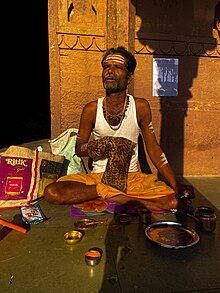| Revision as of 08:44, 19 May 2011 editThisthat2011 (talk | contribs)3,570 editsNo edit summary← Previous edit | Revision as of 23:06, 31 July 2011 edit undoVishvas vasuki (talk | contribs)Extended confirmed users747 editsNo edit summaryNext edit → | ||
| Line 17: | Line 17: | ||
| In ] society, pujaris traditionally belonged to the priestly class in the ] community. | In ] society, pujaris traditionally belonged to the priestly class in the ] community. | ||
| == See Also == | |||
| ], ] | |||
| ] | ] | ||
Revision as of 23:06, 31 July 2011
| This article needs additional citations for verification. Please help improve this article by adding citations to reliable sources. Unsourced material may be challenged and removed. Find sources: "Pujari" – news · newspapers · books · scholar · JSTOR (July 2007) (Learn how and when to remove this message) |
| The neutrality of this article is disputed. Relevant discussion may be found on the talk page. Please do not remove this message until conditions to do so are met. (January 2008) (Learn how and when to remove this message) |
| This article may need to be rewritten to comply with Misplaced Pages's quality standards. You can help. The talk page may contain suggestions. (May 2009) |


Pujari means one who does the Puja of the idol of God physically in Hindu temples as a priest. Pujaris are also called archaka. Pujaris learn and chant hymns (manthras in Sanskrit) dedicated to God, generally in Sanskrit. Pujaris are mainly drawn from the Hindu Brahmin caste.
Pujaris lifestyle
All pujaris are supposed to be vegetarian only.
Pujaris as counselors
Throughout India, pujaris act as counselors during Hindu festivities and festivals. Pujaris have a reputation for being learned.
Other meanings
Pujari is an also Indian surname which means "priest".
In Rajput society, pujaris traditionally belonged to the priestly class in the Kshatriya community.
See Also
This Hinduism-related article is a stub. You can help Misplaced Pages by expanding it. |